_0.jpg)
What is hydroponics? In a nutshell, it is a way of growing plants in an inert substrate such as coconut fiber, rock wool, or simply bare roots. Food is provided to the plants by a nutrient solution, none comes from the substrate; one completely controls the plant nutritional diet. William Texier from Terra Aquatica.
For this technique to give its maximum potential, it is necessary to use dynamic systems, operating in a closed circuit for maximum water savings. Hydroponic techniques provide maximum oxygenation to the roots and therefore accelerates plant growth.
One of the many advantages of hydroponics is that plants grow very fast; but this advantage can sometimes become a disadvantage. If you grow from seed indoor, under a lamp, the plant will be far too big by the time it reaches flowering age. It will have invaded the entire vertical space; this is even truer in grow tents, which don't offer the same height as a room. Artificial light loses much of its effectiveness with distance, so it's a good idea to keep the lamp as close to the plants as possible, hence the interest in small specimens.
For indoor cultivation large plants are more of a handicap, as any plant parts not directly exposed to light will yield a worthless crop in terms of both quantity and quality. To reap the full benefits of hydroponics, you need to adapt your cultivation to this situation: when you start your growing operation by germinating a seed, the plant that emerges from it is not destined to produce flowers.
Step-by-step hydroponics
Let's take, as an example, a 1m2 flowering area (a single lamp). We'll start with a seed, choosing a variety suited to indoor cultivation, i.e. one that won't grow too tall nor flower over a very long period, preferably a hybrid with a rather indica genetic base, so that the plant remains relatively small and stocky, and the flowering cycle doesn't exceed 6 weeks at most. Today, there are many delicious indica-sativa hybrids well suited to this type of cultivation. The seed is placed in a substrate that allows the roots to be easily washed away. This can be coconut fiber, perlite, very light potting soil, or just plain water.
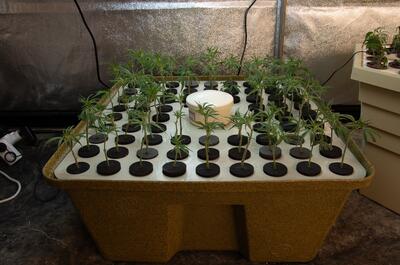
Mother Plant
When the seedling has about two sets of true leaves, carefully dig it up, taking care not to damage the roots. You can use a spoon to do this and scoop out the plant with a little substrate rather than pulling on it. Carefully rinse the roots in a glass of water, then place the plant in the hydroponic system. I like to use a CultiMate system at this stage, which offers good volume for the roots and protection from the clay pebbles against temperature variations. I place it under a weak Turbo neon lamp with a 18h light cycle.
This plant will grow but will never flower; it's a “mother plant”, that is a source for cuttings, which will produce the flowers. When the mother plant reaches 80cm -1 M, I attach small neon lights to the tent frame to illuminate the lower parts which are not in direct contact with the light. It wouldn't do much good to put a more powerful lamp above the plant, it would only increase the difference in quality between top and bottom. If the plant is in a 1.2X1.2 tent, it will quickly take up all the space. Now's the time to make clones.
Cloning
The cuttings will be transplanted into a hydroponic system, so it’s best to root them without substrate, or with a substrate that’s easy to clean. Perlite or coco fiber work well for rooting. Personally, I use the Terra Aquatica hydro cloner, a vortex system that has no equal in terms of success rate and rooting times. We will be flowering small plants, so we need a large number per M2. Depending on the growing system and personal preference, one can use 20 to 30 seedlings per M2.
My flowering system is a Terra Aquatica GrowStream20 perfectly adapted for a 1.2X1.2 tent. I need 20 healthy cuttings, but I prefer to root many more, at least double, and choose the best ones. The key word for successfully growing this way is uniformity. You need to have seedlings that are similar in size and root quality. Choose plants that have root starts all around the stem, that have a bushy root mass and lateral hairs on the roots. With a little experience, you can easily recognize the best clones.
This cutting stage will last about fifteen days in good conditions, sometimes more. It is important to keep high humidity around the clones. If your seedlings are rooted in a hydroponic system, you will be surprised to see them grow before they even have roots. During this whole process, your plants will develop and at the end of rooting, they will no longer look like they did at the beginning. This is another advantage of hydroponics, at no time is there a moment wasted.

Preflowering
We will now transplant our rooted cuttings into the flowering area, under a 600-w lamp or higher. Special feature: you start directly with 12 hours of light, there is no vegetative stage strictly speaking in this type of cultivation. Once again, plants grow very quickly in hydroponics, and having a vegetative cycle would be making the same mistake as trying to flower a plant from seeds; you would get plants that are much too tall, which would go for the lamps, and with such a high number of plants per m2, you would get an unmanageable jungle, a tangle of branches, hotbed for pathogens or insects.
When you put the plants in the flowering area, they seem very small and certainly do not fill all the growing space, but there is a period in the life cycle of cannabis called pre-flowering of about fifteen days during which the plants will grow and modify their structure to accommodate the future inflorescences. By the end of this period, they will occupy all the space reaching a size of about 40 - 50 cm. The length of the pre-flowering cycle and the final size can vary depending on the plant varieties.
During this cycle, one must continue to feed the plant with a vegetative solution, at least for the first 10 days, then it is the eye and experience of the grower that will judge the right moment to change the solution. In all cases, when the first pistils appear it is imperative to switch to a flowering solution. To do this, empty the system and prepare a new solution. To make this process easier, you can let the level drop in the reservoir during the last week of pre-flowering (do not top up) so that you only have to manage a minimum volume of solution.
Flowering
After about 15 days, the plants show clear signs of flowering, with the appearance of the first pistils. By then, the young plants fill the entire growing space. From this moment, the plants still grow a little but in much less proportions than during the first phase. It is time to give them some air; with such a plant concentration, good ventilation is necessary. Cut all the branches that are not directly exposed to light, basically all the low branches. Here again, use your judgment, some lower branches rise quickly and have good potential. After that, not much to do for several weeks, just check the parameters (pH, EC, temperature, humidity) and make sure that no mold comes to wilt the flowers.
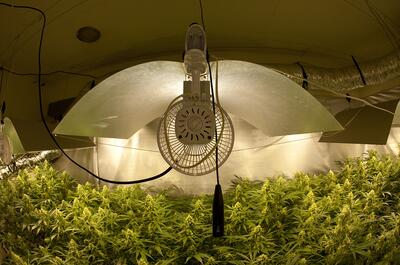
This is the growing method I use and recommend for hydroponics. You won't get the most grams per watt with this technique, but the fact that there is no vegetative stage makes the cycle very short. What's more, the phenomenal acceleration of growth and ripening provided by a truly active hydroponic system shortens the process still further. I save around 2 weeks on the flowering time indicated on the seed packet. I achieve a cycle in less than two months, from 6 to 7 weeks depending on the variety, with the possibility of 5 harvests a year (and a month's vacation). This technique was developed for commercial production, it brings a very high yield in M2/year. With a minimum yield per harvest of 500g/M2, easily achievable, one produces a minimum of 2.5 Kg per M2 per year.
Ideally, the space should be divided into three parts. One for the mother plant, one for the cutting and one, by far the largest, for flowering. A mother plant giving enough cuttings for 2 to 3 m2 of flowering, occupies less than 1m2.
Personally, I have no space for cuttings. I don't keep the mother plant, but rather I select the best clone to be the new mother plant for the next generation. This saves space and electricity, and the new clone will be the perfect size when it's time to take cuttings again. Each cutting is the same age as its mother. When cloning, you don't reset the clock to zero; the plant ages, each generation is older than the last one, and you can observe the aging process, mainly through the roots, which gradually change until they become the large, gnarled roots of an older plant.
I encourage you to try this growing method for yourself. Even if you don't want to go for five annual harvests, which takes time and work, the “cutting technique” is still interesting for one or two consecutive harvests. There's something called “clone vigor”; it's strange, but a cutting is more vigorous than the plant from which it comes, an added advantage. Growing indoors is expensive, especially nowadays with the high price of electricity; anything that makes the process faster results in big savings of money.
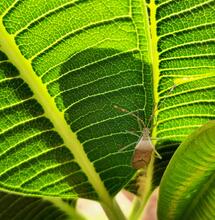
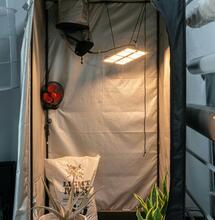
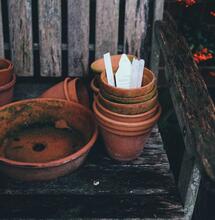
.png)